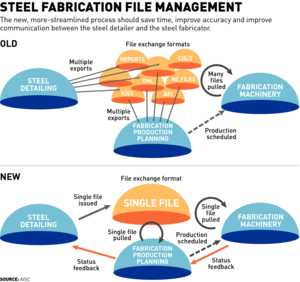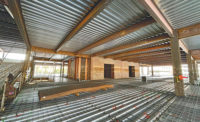The American Institute of Steel Construction is ramping up efforts—at least on the technical side—to ease data exchange among all entities in the structural-steel supply chain. The move is part of AISC's push to help building teams save time and increase efficiency, productivity and accuracy in structural-steel production.
AISC reports headway in building- information-modeling-based automated fabrication and automated steel purchasing and limited progress in steel BIM review, instead of shop-drawing review. But the sharing of steel BIMs between the engineer of record and the steel fabricator—to eliminate duplicate BIM-building efforts—is still a long way off because shared BIM crosses contractual boundaries.
"That remains the huge hiccup," said Chris Moor, AISC's director of technical initiatives, at the 2014 North American Steel Construction Conference, held on March 26-30 in Toronto. "Unless we solve the cultural and educational issues, there is nowhere to go with the design team sharing its BIM with the construction team," he added.
"The Information Delivery Manual" (IDM) for steel, published last year by AISC and the Georgia Institute of Technology under the buildingSMART- alliance's National BIM Standard effort, defines the "data exchange functional requirements and workflow scenarios for exchanges among all the entities involved in the steel supply chain."
But the road map addresses only technical issues. "The cultural and social aspects related to risk, standard of care, contractual vehicles and more are beyond the scope of the IDM and AISC," says Sean B. Smith, a senior associate structural engineer with SSOE Group and a member of AISC's technology integration committee. "Crossing contractual boundaries is the elephant in the room," he adds.
One of AISC's "BIMsteel" initiatives deals with the technical aspects of architect-engineer-contractor handoffs to reuse the "design BIM." But there is no industry initiative to remove the contractual barriers to sharing BIMs, said Moor.
Moor is much more enthusiastic about the other three BIMsteel initiatives: automated fabrication, model review and automated purchasing. The automated fabrication initiative grew out of AISC's understanding that fabricators have two goals: standardized output from detailing tools to work with any computer numerically controlled (CNC) equipment and a single file with all relevant information for the equipment.
Automated fabrication "will save time, improve accuracy and improve communication between the detailer and fabricator by eliminating the need for complex setups and production and sharing of multiple proprietary file formats," said Moor.
In addition, the project enables steel fabricators to take advantage of leading- edge technology, including robotic machines, added Moor.
The fabrication process begins with the detailed model of the structure. Currently, the detailer must export multiple files with multiple settings to the fabricator for production planning. Also, the CNC equipment must pull multiple files for fabrication. For example, a beam typically has separate, numerically controlled files for cuts, drill holes and copes.





Post a comment to this article
Report Abusive Comment